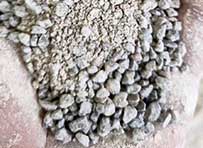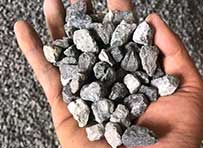With the development of society, the demand for sandstone, especially the artificial sand, is increasing day by day. There are two kinds of artificial sand production line, one is wet sand production line and the other is dry sand production line. What are their differences?
Different working principles
Working principle and flowsheet of dry sand production line
There are two types of dry sand-making processes: tower-type and flat-layout dry sand producing systems. The stone material is evenly sent to the jaw crusher by the vibrating feeder for coarse crushing, and then the coarsely crushed material is sent to the impact crusher for secondary crushing.
The material produced by impact rock crusher needs to be further processed by sand making machine to procced the finest-crushing stage. The material discharged from the sand-making machine needs the screening process to classify the desired product and undesired product.

If the material does not meet the size requirement, it should be sent back to sand making machine for another round of crushing. The dust produced in the vibration screening process will enter the pulse dust collector after passing through the classifier.
In the dry sand production process, mud or powder removed by the sand maker from artificial sand can not only reduce the amount of clay in the artificial sand but ensure the quality and production of artificial sand.
Using a powder selecting machine to separate dust from sand can effectively make the excellent sand building material and collect dust as a by-product.
Working principle and flowsheet of wet sand production line
Water, as a working medium and measure to suppress dust in the wet sand production line, participates in the production of sand and gravel aggregates throughout the process.
The large stones are evenly sent to the jaw crusher by the vibrating feeder for primary crushing, and the coarsely crushed stones are sent to the cone crusher by the belt conveyor for secondary crushing.

After being processed by a cone crusher, the material will be sent to the vibrating screen by a belt conveyor for screening. Then the material is sent to the sand washing machine by the belt conveyor to remove dirt, dust, and other impurities.
During the sand-making process, if the material is still oversize, the sand-making machine can rehandle and reshape it to a smaller size. At last, the finely crushed material is sent to the vibrating screen again for screening, thus forming a closed circuit for multiple cycles.
Different applicable conditions
Applicable conditions of dry sand making line
-
 Mostly used in areas with aridity, less rainfall and lack of water resources.
Mostly used in areas with aridity, less rainfall and lack of water resources.
-
 Used when the requirements for aggregate quality, stone powder content are not high for sand and gravel production.
Used when the requirements for aggregate quality, stone powder content are not high for sand and gravel production.
-
 Higher requirements for equipment automation control.
Higher requirements for equipment automation control.
Applicable conditions of wet sand making line
-
 The project site is near the water area in which a sedimentation tank can be built to recover the water.
The project site is near the water area in which a sedimentation tank can be built to recover the water.
-
 Suitable for areas with a lot of rain and sufficient water resources.
Suitable for areas with a lot of rain and sufficient water resources.
-
 There are strict requirements on the shape, look and texture of the final product.
There are strict requirements on the shape, look and texture of the final product.
Dry and wet sand making production lines have their own different advantages
Advantages of dry sand production line

- 1The finished aggregate and artificial sand have a low moisture content, generally not higher than 2%, and can be directly transported to use. Even if the temperature is lower than zero in winter, the sand made by the dry sand production line will not freeze and can be produced continuously throughout the year.
- 2By adjusting the air volume and air pressure of the classifier, the content of stone powder in the finished sand can be controlled, and the sand production rate is higher than that of wet sand.
- 3It can realize automatic production operations with high production capacity and low production cost.
- 4The dry sand production line can achieve high rate of resource utilization and zero emissions because the by-product fine dust or powder collected in the production process can be used as a roadbed cushion or as a raw material for cement non-burning bricks.
- 5The whole production line hardly needs water and thus cutting the cost for drainage and sewage treatment equipment. The simple operation system needs only less investment due to the small footprint occupied and few operators.
- 6The final product can directly meet the mandatory requirements of the land construction engineering standards and urban construction related standards, and the concrete strength made from dry sand is also relatively high.
swipe to view a full table
| Gradation of sand | ||||||
|---|---|---|---|---|---|---|
| Types of sand | Natural sand | Artificial sand | ||||
| Square mesh | Accumulated retained percentage% | |||||
| Sand grading standard region | Zone 1 | Zone 2 | Zone 3 | Zone 1 | Zone 2 | Zone 3 |
| 4.75mm | 10~0 | 10~0 | 10~0 | 10~0 | 10~0 | 10~0 |
| 2.36mm | 35~5 | 25~0 | 15~0 | 35~5 | 25~0 | 15~0 |
| 1.18mm | 65~35 | 50~10 | 25~0 | 65~35 | 50~10 | 25~0 |
| 600μm | 85~71 | 70~41 | 40~16 | 85~71 | 70~41 | 40~16 |
| 300μm | 95~ 80 | 92~70 | 85~55 | 95~ 80 | 92~70 | 85~55 |
| 150μm | 100~90 | 100~90 | 100~90 | 97~85 | 94~80 | 94~75 |
| Sand classification | |||
|---|---|---|---|
| Classification | Ⅰ | Ⅱ | Ⅲ |
| Sand grading standard region | Zone 2 | Zone 1, zone 2, zone 3 | Zone 1, zone 2, zone 3 |
| Standard of powder and mud content | |||
|---|---|---|---|
| Categories | Ⅰ | Ⅱ | Ⅲ |
| Powder content (by mass)% | ≤1.0 | ≤1.0 | ≤5.0 |
| Mud content(by mass)% | 0 | ≤1.0 | ≤2.0 |
Advantages of dry wet production line

- 1The finished sand and gravel aggregate has good appearance and beautiful particle shapes.
- 2During the production process, the soil and stone powder are taken away by the water flow, generating no dust and air pollution.
Dry sand and wet sand production lines face their own limitations
Limitations of dry sand production line
- 1Sensitive to the content of impurities such as clay and organic matter in the raw materials, it causes blockage and overload of the dust collection system.
- 2There is a certain amount of stone powder residue on the surface of the finished sand, and the cleanliness is not high. The cleanness of the finished sand is not high because there is a certain amount of stone powder residue on its surface.
- 3Dust will generate in the crushing and screening stage and artificial sand-making part. Therefore, production equipment and conveying equipment need to work in a fully enclosed factory.
Limitations of wet sand production line
- 1Consume a lot of water resources. One ton of sand and gravel consumes about 2~3.5t water.
- 2The mud and powder sewage generated in the sand-making process is directly discharged into the land. The conduct will cause environmental pollution, but the recycling process will require a lot of investment and cost.
- 3It is highly dependent on water resources and is only suitable for areas with abundant water resources. In addition, normal production is not possible when the temperature is below zero in winter.
- 4In addition, the finished sand has a high-water content which also does not meet the requirements of water content less than 6%.
- 5The need of water supply and drainage, sewage treatment equipment and vast land leads to high unit cost of finished sand and gravel aggregate.
- 6The output of finished sand is low. The proportion of particles with a size of less than 0.16mm does not meet the requirements of the fineness modulus and stone powder content.
How to make the right choice between dry sand and wet sand production lines?

In the preliminary design of the production line, firstly take the water supply, protection, and governance into consideration.
Therefore, choose the dry sand process if permitted, and only consider the wet sand process when the product does not meet the requirements of the market and engineering construction.
In addition, considering other factors, such as capital investment, equipment management, degree of automation, land occupation, and production cost per ton, you should also give priority to dry sand making line then dry-wet combined method and wet sand producing line.




